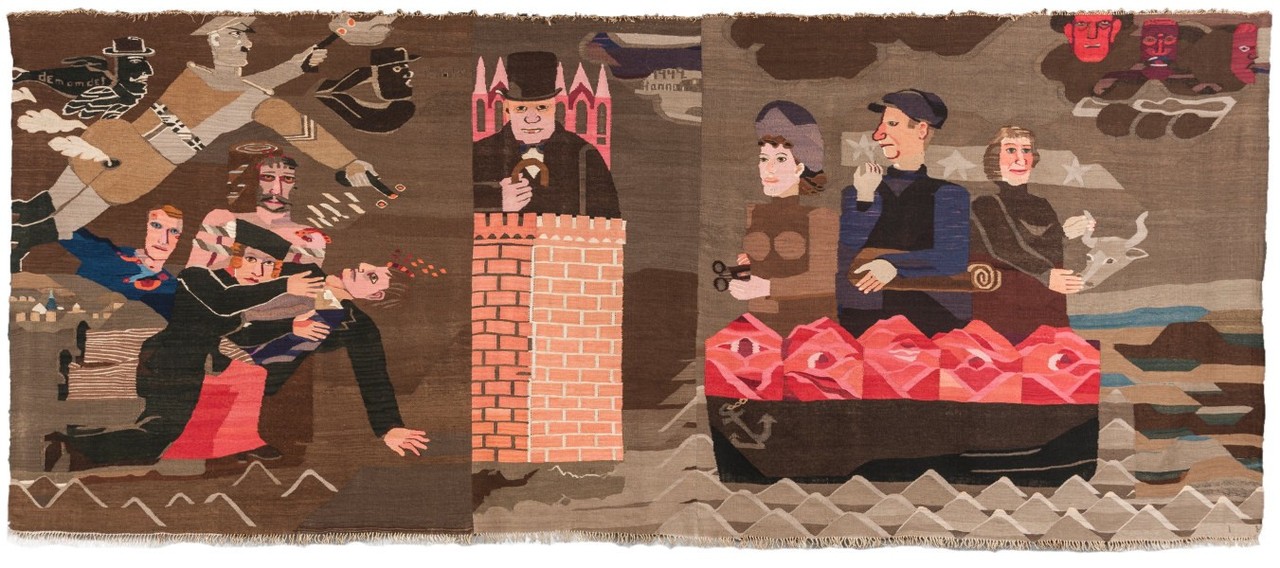Hannah Ryggen
11 Nov 2017 - 18 Feb 2018
HANNAH RYGGEN
11 November 2017 — 18 February 2018
Hannah Ryggen was one of Scandinavia’s most outstanding artistic figures of the 20th century. In the first major presentation of the artist’s work in the UK, this exhibition surveys her career from an early painted portrait created in 1914, to the intricate tapestries that characterised her extraordinary career from the 1920s onward.
Ryggen’s work demonstrated her impassioned responses to the socio-political events of her time. She dealt with a range of issues from the rise of fascism (Ethiopia, 1935) and the Nazi occupation of Norway, including its impact on her own family (6 October 1942, 1943); to the post-war growth of nuclear power (Mr Atom, 1952) and media coverage of the Vietnam War (Blood in the Grass, 1966).
The artist’s intense relationship to the world around her forms the heart of this exhibition, which celebrates both her vibrant tapestries and the processes involved in creating them.
Born in 1894 in Malmö, Sweden, Hannah Ryggen’s introduction to art began with evening classes in painting, whilst working as a teacher. It was not until a study visit to Dresden in 1922 that she stopped painting in favour of dedicating her artistic career to weaving.
In 1924, Ryggen moved with her husband to Ørlandet – a remote region in Norway’s Trondheimsfjord. Here Ryggen taught herself the various processes of tapestry making, from the carding and spinning of wool, to the concoction of locally-sourced natural dyes from insects, plants, lichens and bark.
While Ryggen was included in several major international exhibitions in the 1950s and '60s, she remains largely unknown outside of Scandinavia. Recent showcases of her work include dOCUMENTA 13 in Kassel (2012) and a major retrospective at the National Gallery, Oslo and Moderna Museet in Malmö (Weaving the World, 2015/6).
The exhibition has been organised in partnership with Nordenfjeldske Kunstindustrimuseum / Museene I Sør-Trøndelag.
11 November 2017 — 18 February 2018
Hannah Ryggen was one of Scandinavia’s most outstanding artistic figures of the 20th century. In the first major presentation of the artist’s work in the UK, this exhibition surveys her career from an early painted portrait created in 1914, to the intricate tapestries that characterised her extraordinary career from the 1920s onward.
Ryggen’s work demonstrated her impassioned responses to the socio-political events of her time. She dealt with a range of issues from the rise of fascism (Ethiopia, 1935) and the Nazi occupation of Norway, including its impact on her own family (6 October 1942, 1943); to the post-war growth of nuclear power (Mr Atom, 1952) and media coverage of the Vietnam War (Blood in the Grass, 1966).
The artist’s intense relationship to the world around her forms the heart of this exhibition, which celebrates both her vibrant tapestries and the processes involved in creating them.
Born in 1894 in Malmö, Sweden, Hannah Ryggen’s introduction to art began with evening classes in painting, whilst working as a teacher. It was not until a study visit to Dresden in 1922 that she stopped painting in favour of dedicating her artistic career to weaving.
In 1924, Ryggen moved with her husband to Ørlandet – a remote region in Norway’s Trondheimsfjord. Here Ryggen taught herself the various processes of tapestry making, from the carding and spinning of wool, to the concoction of locally-sourced natural dyes from insects, plants, lichens and bark.
While Ryggen was included in several major international exhibitions in the 1950s and '60s, she remains largely unknown outside of Scandinavia. Recent showcases of her work include dOCUMENTA 13 in Kassel (2012) and a major retrospective at the National Gallery, Oslo and Moderna Museet in Malmö (Weaving the World, 2015/6).
The exhibition has been organised in partnership with Nordenfjeldske Kunstindustrimuseum / Museene I Sør-Trøndelag.

